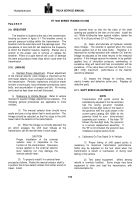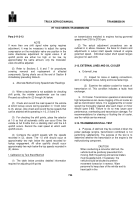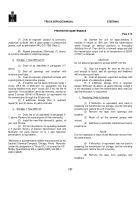TM-5-3805-254-14-P-2 - Page 710 of 894
TRUCK SERVICE MANUAL
TRANSMISSION
PREVENTIVE MAINTENANCE
Para 3-11
observing performance.
Other shops may have test
stands on which the valve body and governor can be
calibrated before installation into the transmission. If test
stand equipment is not available, satisfactory calibrations
of shift points may be made after road testing of the
vehicle.
b
.
Location of Adjusting Components
(1
)
Shift speeds are changed by changing the
positions of adjusting rings that determine the retaining
force of certain valve springs in the valve body. Refer to
items 80, 85, 81 and 22 (B, foldout 16) and 15 (A, foldout
17).
(2
)
A special tool J24314 (item 45, fig. 4-3) is used
to depress and rotate the adjusting rings to the proper
positions. Clockwise rotation increases spring force and
will raise the shift point. Counterclockwise rotation will
reduce spring force, and lower the shift point.
NOTE
Each notch of adjustment will alter the shift point as
follows.
HT 750CRD
Shift 1-2 - 10 rpm
Shift 2-3 -
10 rpm
Shift 3-4 - 25 rpm
Shift 4-5 - 35 rpm
c
.
Checks Before Adjusting Shift Points
(1
)
When calibration is to be made during a road
test, or on a test stand that simulates road operation,
certain preparations must be made.
(2
)
Raise the temperature of the transmission fluid in
the transmission or test stand to (160° to 220°F [71 to
1040C]).
(3
)
Check the engine no-load governor setting, and
adjust if required, to conform to the transmission's engine
speed requirements.
(4
)
Check the engine for satisfactory performance
before making shift point adjustments.
(5
)
Check the throttle linkage that controls the
mechanical modulator valve actuator
on the transmission for proper travel, routing and
operation.
(6
)
Check the shift selector linkage for proper range
selection.
(7
)
Provide accurate instrumentation required for
observing speeds, temperatures, pressures, etc.
d
.
Calibration by Road Test Method
NOTE
Before road test, determine the vehicle tachometer error
with a test tachometer. Make corrections for error, as
required, in subsequent tests.
(1
)
Check the no-load governed speed of the
engine. Adjust the governor, if necessary, to meet the no-
load governed speed specified for your particular engine-
transmission
match
(available
from
vehicle
manufacturer).
(2
)
Note the engine speed and record it. Subtract
100 rpm, and record the remainder as the desired speed
for all automatic upshifts
except the 1-2 shift This shift
must occur at 100 rpm below lockup engagement speed.
(3
)
If doubt exists regarding when
lockup
is
occurring , install a 0-300 psi (0-2068 kPa) gage at the
lockup pressure tap. Duringroad operation in 1-hold
observe the first movement of the gage and note rpm.
This is first gear lockup engagement speed.
(4
)
While driving the vehicle in 2-5 range, check the
wide open throttle upshift points. These shifts should
occur at 100 rpm below engine no-load governed speed.
If upshift speed points do not reach those specified, the
shiftpoint speed may be raised by adjusting (increasing)
the spring load on the 1-2, 2-3, 3-4 or 4-5 shift signal
valve.
If upshift speeds are above those engine speeds
specified, or do not occur at all, the spring load(s)
must be reduced. Only the load on springs for the valve
(or valves) which do not upshift at the proper speed
require adjustment.
703
Back to Top




















